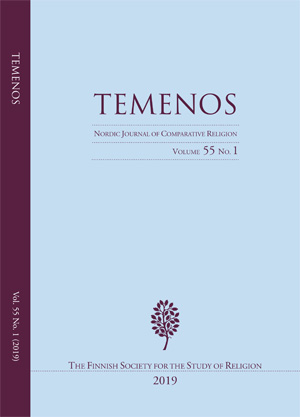The Materiality of Myth
Divine Objects in Norse Mythology
DOI:
https://doi.org/10.33356/temenos.83424Abstract
The vivid presence of material objects in Scandinavian cosmology, as preserved in the Old Norse myths, carries underexplored traces of belief systems and the material experience of Iron Age Scandinavia (400–1000 CE). This paper proposes an archaeological reading of Norse mythology to help explain how ancient Scandinavians understood the presence and role of deities, magic, and the supernatural in everyday life. The Norse myths retain records of material objects that reinforced Scandinavian oral traditions and gave their stories power, memory, and influence. From Thor’s hammer and Freyja’s feathered cloak to Sigyn’s bowl and Ran’s net, such materials and the stories they colour are informed by everyday objects of Iron Age life – spun with the magic, belief, and narrative traditions that made them icons. The mythic objects promoted a belief system that expected and embraced the imperfections of objects, much like deities. These imperfections in the divine Norse objects and the ways in which the gods interact with their materials are part and parcel of the Scandinavian religious mentality and collective social reality. This work ultimately questions the relationship between materiality and myth, and seeks to nuance our current understandings of the ancient Scandinavian worldview based on the available textual evidence.
Downloads
Published
Issue
Section
License
Copyright (c) 2019 Temenos - Nordic Journal of Comparative Religion

This work is licensed under a Creative Commons Attribution-NonCommercial-NoDerivatives 3.0 Unported License.
Author's Guarantee
- The Author acknowledges that the Work will be publicly accessible on the Internet and that such access will be free of charge for the readers.
- The Author guarantees that the Work is her/his original work that has not been published before and cannot be construed as copying or plagiarism. Furthermore, the Author confirms that the Work contains no statement that is unlawful, defamatory or abusive or in any way infringes the rights of others.
- The Author confirms that she/he has secured all written permissions needed for the reproduction in the Publication of any material created by a third party.
User Rights
Under the CC BY 4.0 license, the Author/s and users are free to:
- Share — copy and redistribute the material in any medium or format,
- Adapt — remix, transform, and build upon the material for any purpose, even commercially,
- However, the Work must be attributed to the original Author and source of publication.
The license of the published metadata is Creative Commons CCO 1.0 Universal (CC0 1.0)
Author Rights
The Authors maintain the right to:
- copyright, and other proprietary rights relating to the Work,
- the right to use the substance of the Work in future own works,
- the right to self-archiving/parallel publishing (publisher's PDF allowed).
Rights of Publisher
- The Publisher reserves the right to make such editorial changes as may be necessary to make the Work suitable for publication in the publication, e.g. style of punctuation, spelling, headings and the like.
- The Publisher will publish the Work if the editorial process is successfully completed and reserves the right not to proceed with publication for whatever reason.
- The publication entitles the author to no royalties or other fees. This agreement will be governed by the laws of Finland.






